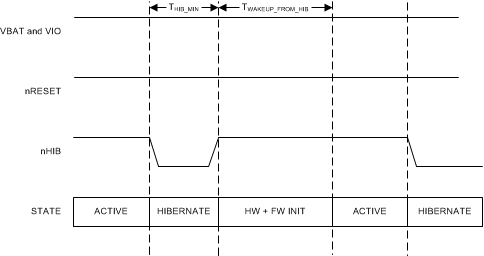ZHCSM59B November 2014 – September 2020 CC3100MOD
PRODUCTION DATA
- 1 特性
- 2 应用
- 3 说明
- 4 功能方框图
- 5 功能方框图
- 6 Revision History
- 7 Terminal Configuration and Functions
-
8 Specifications
- 8.1 Absolute Maximum Ratings
- 8.2 ESD Ratings
- 8.3 Power-On Hours (POH)
- 8.4 Recommended Operating Conditions
- 8.5 Power Consumption Summary
- 8.6 TX Power and IBAT versus TX Power Level Settings
- 8.7 Brownout and Blackout Conditions
- 8.8 Electrical Characteristics (3.3 V, 25°C)
- 8.9 WLAN RF Characteristics
- 8.10 Reset Requirement
- 8.11 Thermal Resistance Characteristics for MOB Package
- 8.12 Timing and Switching Characteristics
- 8.13 Host UART
- 9 Detailed Description
- 10Applications, Implementation, and Layout
- 11Environmental Requirements and Specifications
- 12Device and Documentation Support
- 13Mechanical, Packaging, and Orderable Information
8.12.2 Wake Up From Hibernate
#SWAS0318564 shows the timing diagram for wake up from the hibernate state.
 Figure 8-7 nHIB Timing Diagram
Figure 8-7 nHIB Timing DiagramNote:
The internal 32.768-kHz crystal oscillator is kept enabled by default when the chip goes to hibernate in response to nHIB being pulled low.
GUID-400CF46C-B651-457D-A1D7-C5F78DD51018.html#GUID-400CF46C-B651-457D-A1D7-C5F78DD51018 describes the timing requirements for nHIB.